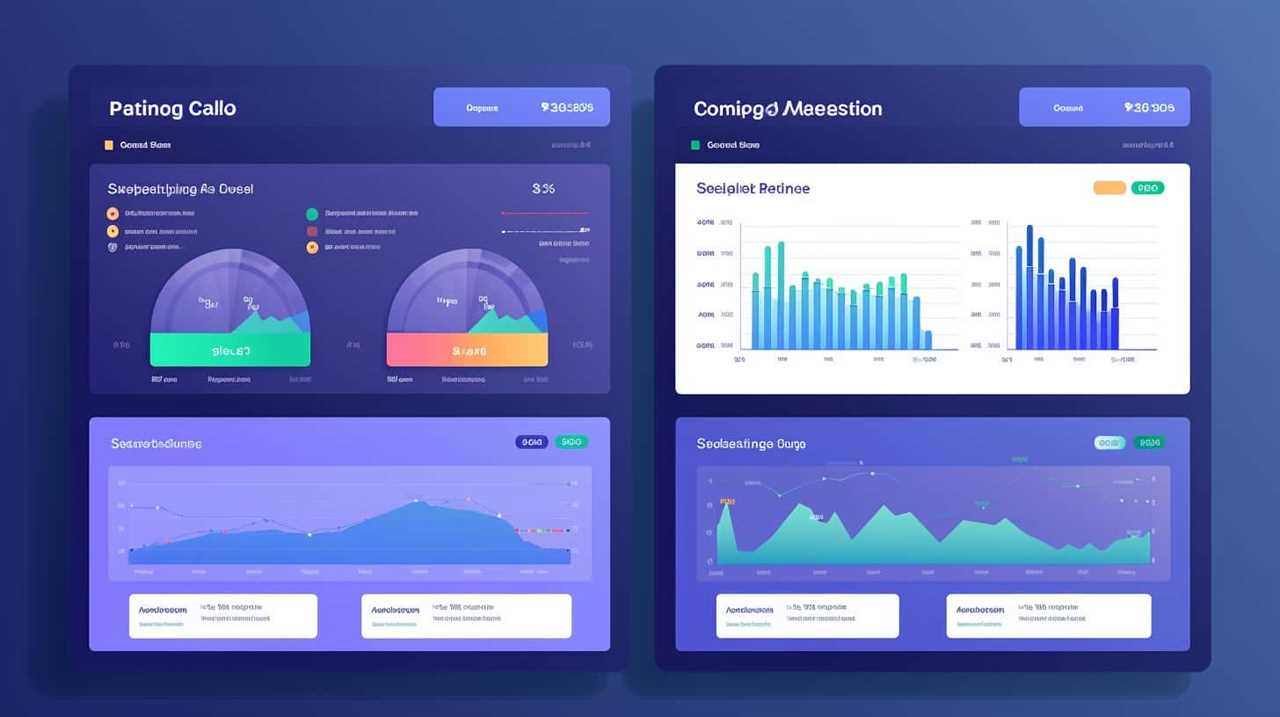Predictive SEO uses AI to identify emerging ranking opportunities, changing how you plan your search strategies. By analyzing historical data and current trends, it helps you understand user intent better and align your content with what people are searching for. This proactive approach allows you to discover high-potential keywords early, optimize your resources, and drive higher engagement. Tools like Google Trends and SEMrush enhance your insights, guiding content updates and strategy adjustments. By tapping into these advantages, you can stay ahead of the competition. There's so much more to uncover about maximizing your SEO potential.
Key Takeaways
- Predictive SEO utilizes AI to analyze historical data, forecasting search trends and aligning content strategies with user intent.
- It identifies emerging keywords with less competition, allowing marketers to capitalize on trends before they become mainstream.
- Tools like Google Analytics and SEMrush provide insights for keyword research, user behavior, and performance metrics to enhance content strategies.
- Predictive analytics helps allocate resources efficiently, targeting high-value users and boosting ROI by aligning content with anticipated search behaviors.
- Regular content updates and optimization based on predictive insights improve user engagement and enhance ranking opportunities on search engines.
Understanding Predictive SEO
As you explore the world of Predictive SEO, you'll discover how it harnesses the power of AI to analyze historical data, allowing you to forecast future search trends.
This innovative approach helps you understand user intent more deeply, enabling you to align your content strategy with what potential customers are seeking. By identifying emerging keyword opportunities before they become mainstream, you can proactively create content that resonates with your audience.
Utilizing insights from social media analytics can further enhance your understanding of audience preferences and behaviors.
Predictive SEO shifts your strategy from reactive to proactive, giving you the chance to make timely adjustments in your content and SEO tactics.
You'll find that tools like Google Trends and Google Search Console are invaluable, providing real-time insights into keyword performance and seasonal trends. These insights help you prioritize your SEO efforts based on their potential impact on rankings and guide your budget allocation towards high-ROI opportunities.
Key Tools for Predictive SEO

In the domain of Predictive SEO, having the right tools at your disposal can make all the difference. Google Analytics is essential for tracking website traffic and user behavior. It helps you refine your content strategy based on user preferences and identify high-value content opportunities.
Implementing keyword clustering and topic clustering enhances your SEO strategy by organizing content around central themes, leading to better discoverability.
Google Trends offers real-time insights into search user interests, allowing you to spot seasonal patterns and emerging topics. This can be invaluable for planning your content strategy effectively.
Meanwhile, Google Search Console provides critical performance metrics like click-through rates and impressions. These metrics can help you prioritize which high-potential pages to optimize.
For thorough keyword research, tools like Ahrefs and SEMrush are indispensable. They assist in analyzing keyword volume trends and generating related keywords, ensuring you're targeting the right phrases to boost your rankings.
Additionally, integrating predictive analytics from tools like GA4 can forecast user behavior and potential revenue. This gives you data-driven insights that refine your targeted SEO strategies, helping you stay a step ahead in the competitive landscape.
The Role of AI in SEO

AI-driven insights are transforming how you approach SEO by providing a clearer understanding of user behavior.
With predictive analytics, you can anticipate trends and optimize your content strategy effectively.
This balance between innovation and privacy rights is essential as you refine your SEO tactics.
This not only boosts your website's visibility but also enhances your overall return on investment.
AI-Driven Insights
Harnessing the power of AI-driven insights transforms how you approach SEO by using historical data patterns to predict future search trends.
With predictive analytics tools like Google Analytics 4, you can leverage machine learning to identify high-value users and anticipate their behavior. This includes understanding metrics such as purchase probability and churn probability, guiding your strategy effectively.
As the demand for AI ethics education grows, it's crucial to guarantee that your AI tools are developed with fairness and transparency in mind.
By analyzing user intent behind keywords, AI tools offer tailored content optimizations that resonate with your potential customers. This not only improves engagement but also boosts conversion rates.
Advanced AI algorithms process vast amounts of data rapidly, providing real-time insights that empower you to adjust your strategies proactively. You won't just react to market changes; you'll anticipate them.
Moreover, integrating AI in your SEO efforts helps you discover emerging keywords with lower competition.
These AI-driven insights enable you to stay ahead of market trends and competitor strategies, guaranteeing your keyword research is always relevant and impactful.
In a landscape that evolves quickly, these insights are invaluable for crafting a content strategy that meets your audience's needs and drives results.
Predictive Analytics Benefits
Predictive analytics revolutionizes SEO by leveraging historical data and machine learning to forecast user behavior. By harnessing these insights, you can refine your SEO strategies, ensuring your content resonates with users before trends even emerge.
Additionally, understanding the importance of mastering music production software can enhance your ability to create engaging and relevant content that attracts more traffic.
Here are some key benefits of integrating predictive analytics into your SEO efforts:
- Identifies High-Potential Keywords: Catch trending topics early, allowing you to create content that aligns with user interests.
- Enhances Content Optimization: Tailor your content to meet predicted user needs, improving engagement and satisfaction.
- Improves Resource Allocation: Prioritize tasks based on data-driven forecasts, maximizing your return on investment.
- Targets High-Value Users: Utilize tools like Google Analytics 4 to understand purchase and churn probabilities, focusing on users who matter most.
- Boosts ROI Considerably: Align your content with future search behaviors, leading to increased user experience and interaction on your site.
Applications of Predictive Analytics

In the domain of SEO, predictive analytics offers powerful tools for anticipating trends and audience behavior. By leveraging historical data, you can forecast emerging keyword trends that help you identify high-potential keywords before they gain traction. This proactive approach allows you to optimize your content strategies based on real user behavior and search patterns.
Here's a snapshot of how predictive analytics can enhance your SEO efforts:
| Application | Description | Benefits |
|---|---|---|
| Keyword Trend Forecasting | Identifies high-potential keywords early | Increases organic traffic potential |
| Content Optimization | Aligns content strategies with audience needs | Enhances user engagement and CTR |
| Resource Allocation | Targets areas likely to yield high ROI | Maximizes efficiency and profitability |
Tools like Google Trends and Google Analytics 4 (GA4) provide real-time insights that inform your SEO tactics. By implementing predictive analytics, you not only forecast which content titles will resonate but also drive higher engagement, improving your click-through rates. Embracing these applications will set your SEO efforts apart in a competitive landscape.
Statistical Forecasting in SEO

Analyzing historical performance data alongside current trends enables SEO professionals to forecast future ranking possibilities for specific keywords and content effectively.
By leveraging statistical forecasting, you can tap into valuable insights that guide your SEO strategy. Additionally, understanding market trends can be essential in identifying opportunities for content related to avoiding scams in investments and other financial topics.
Here are key aspects to reflect on when utilizing statistical forecasting in SEO:
- Identify High-Potential Keywords: Focus on keywords that show promise based on historical data and current search trends.
- Prioritize Content Creation: Allocate resources to develop content that aligns with predicted ranking opportunities.
- Monitor Engagement Metrics: Analyze click-through rates (CTR), impressions, and user engagement to refine your forecasts.
- Allocate Resources Wisely: Use forecasting data to optimize your budget and resource distribution for SEO campaigns.
- Adapt to Changes: Regularly update your forecasts with new data to guarantee your strategies remain effective amidst evolving algorithms.
Identifying Ranking Opportunities

Harnessing historical search data and current trends is key to pinpointing ranking opportunities for your SEO strategy. By leveraging predictive analytics, you can anticipate which keywords are likely to gain traction in the near future. Tools like Google Trends help uncover seasonal patterns and emerging keywords that resonate with user interests. This insight allows you to create content proactively, ensuring you're ahead of the curve.
Additionally, understanding the importance of continuous learning, as seen in hackathon trends, can enhance your ability to adapt your SEO strategies effectively.
Analyzing click-through rates (CTR) and user behavior metrics from Google Search Console is essential. It helps you identify high-potential pages that deserve optimization, maximizing your chances of ranking higher.
Additionally, understanding competitive analysis through platforms such as SEMrush reveals gaps in competitors' keyword strategies. This knowledge highlights areas where you can introduce new content to capture valuable ranking opportunities.
Optimizing User Experience

When you optimize user experience, you're not just improving how visitors interact with your site; you're boosting your SEO performance too.
Enhancing site navigation, personalizing content delivery, and streamlining page load speed can make a notable difference in user engagement and conversions.
For instance, the presence of security systems can greatly enhance user experience by providing peace of mind and a sense of safety, which can lead to longer site visits and higher engagement rates increased safety and peace of mind.
Enhancing Site Navigation
Enhancing site navigation is essential for creating an intuitive user experience that keeps visitors engaged. By leveraging AI tools like Google Analytics 4, you can analyze user behavior patterns to identify drop-off points and streamline pathways. This proactive approach improves overall site navigation, ensuring users find what they need quickly and efficiently.
Additionally, a methodical approach to site structure, similar to what successful SQA Engineers employ in their testing processes, can greatly enhance navigation efficiency.
Here are some strategies to enhance site navigation:
- Utilize predictive analytics to forecast the impact of changes in site architecture.
- Implement structured data to provide clear context and improve visibility in search engine results.
- Regularly test navigation based on predictive insights to adapt to evolving user preferences.
- Focus on reducing bounce rates by optimizing pathways that guide users seamlessly.
- Prioritize modifications that are likely to enhance user satisfaction and increase conversion rates.
Personalizing Content Delivery
Personalizing content delivery is essential for optimizing user experience and keeping visitors engaged with your site. By utilizing predictive analytics, you can analyze historical data to anticipate user preferences and tailor content to their specific interests. This approach not only enhances the relevance of your content but also fosters a deeper connection with your audience.
For instance, understanding dog health and nutrition can help you create content that resonates with pet owners who are concerned about their dogs' well-being.
When you leverage tools like Google Analytics 4 (GA4), you can identify high-value users and predict their content preferences based on user behavior. This allows you to create dynamic content recommendations that adapt in real-time, increasing engagement and overall satisfaction.
Furthermore, predictive SEO can help you forecast seasonal trends and shifts in user behavior. By delivering timely and relevant content, you can align your offerings with your audience's evolving needs.
Implementing AI-driven insights into your content strategy is vital for understanding drop-off points in user journeys. This understanding enables you to adjust content delivery effectively, ultimately improving conversion rates.
Streamlining Page Load Speed
User experience hinges not just on relevant content but also on how quickly that content loads. If your site takes longer than three seconds to load, you risk losing over half of your mobile users.
To improve your page load speed and guarantee a better user experience, focus on optimizing your content with the following strategies:
- Optimize images: Compress and resize images for faster loading times.
- Leverage browser caching: Store frequently accessed files locally to reduce load times for returning visitors.
- Reduce server response times: Choose a reliable hosting provider that minimizes delays.
- Minimize JavaScript and CSS: Remove unnecessary code to streamline loading processes.
- Utilize Google PageSpeed Insights: Get actionable recommendations to enhance performance based on Core Web Vitals metrics like LCP, FID, and CLS.
Enhancing Content Strategy

Revealing the potential of predictive SEO can transform your content strategy greatly. By harnessing predictive analytics, you can analyze historical search data to forecast trending topics, enabling you to create relevant content ahead of demand peaks.
This proactive approach means you'll stay ahead of the curve, guaranteeing your content resonates with your audience when it matters most.
Utilizing tools like Google Trends allows you to identify seasonal patterns and emerging keywords, so you can align your content calendar with anticipated interests. By focusing on high-potential keywords with strong commercial intent, you'll guide your content creation toward topics that drive traffic and conversions.
Incorporating AI-driven insights from platforms like Google Analytics 4 refines your strategy by predicting user behavior and engagement metrics. This guarantees your content not only attracts but also engages your target audience effectively.
Moreover, regularly updating existing content based on predicted trends and user intent can markedly improve your search rankings. In an ever-evolving digital landscape, staying relevant is vital, and predictive SEO equips you with the tools to achieve just that.
Embrace predictive SEO to elevate your content strategy and boost your online visibility.
Future Trends in Predictive SEO

As you explore future trends in predictive SEO, you'll see how evolving algorithms will adapt to better analyze user behavior and preferences.
This shift will empower you to develop data-driven content strategies that resonate with your audience.
Plus, with enhanced user experience insights, you'll be able to create more engaging and relevant content that meets their needs.
Evolving Algorithm Adaptation
While the digital landscape continuously evolves, businesses must stay ahead by embracing predictive SEO strategies that adapt to changing algorithms.
Predictive analytics is essential for understanding and anticipating algorithm updates, ensuring your content remains relevant and authoritative. By leveraging machine learning, you can analyze historical data to identify patterns that inform your future strategies.
Here are some key trends to keep in mind for evolving algorithm adaptation:
- Natural Language Processing (NLP): Enhances content relevance by improving search engines' understanding of user intent and context.
- Voice Search Optimization: Focuses on conversational queries to align with the rise of AI-driven search experiences.
- Structured Data Implementation: Utilizes schema markup to help search engines comprehend content context and improve visibility.
- Continuous Monitoring: Tracks algorithm updates and user engagement metrics to refine your predictive SEO strategies.
- Proactive Adaptation: Adjusts your content and strategies in response to anticipated changes in user behavior.
Data-Driven Content Strategies
In a world where data drives decision-making, adopting data-driven content strategies has become essential for successful predictive SEO. By leveraging predictive analytics, you can analyze historical search data to forecast future ranking opportunities. This insight allows you to tailor your content strategies to align with emerging search trends, guaranteeing you're always a step ahead.
Utilizing tools like Google Trends and Google Analytics 4 (GA4) empowers you to identify seasonal trends and high-potential keywords. With this information, you can create proactive content that resonates with your target audience, meeting their specific needs and preferences. This approach not only enhances user engagement but also improves your conversion rates.
Additionally, by focusing your resources on areas identified through predictive models, you maximize your ROI in content marketing efforts. Continuous monitoring and refinement of your content based on predictive insights guarantee that your strategies remain relevant, adapting to shifts in search engine algorithms and user behavior.
Embracing data-driven content strategies positions you to thrive in the ever-evolving digital landscape, keeping your brand competitive and visible.
Enhanced User Experience Insights
Enhanced user experience insights play an essential role in the future of predictive SEO. By leveraging AI to anticipate user intent, you can create relevant content that engages users before trends even emerge. This proactive approach fosters greater satisfaction and retention.
Here's how enhanced user experience can transform your strategies:
- Anticipate user intent: Predict what users are searching for, allowing you to deliver content that meets their needs.
- Predictive insights: Use historical data to identify potential drop-off points in user journeys, enabling timely adjustments to your content.
- Seasonal trend predictions: Prepare relevant content in advance, ensuring that you're ready during peak interest periods.
- Enhanced personalization: Dynamically adjust content based on predicted user behavior, leading to a more tailored experience.
- Utilize tools like GA4: Leverage predictive metrics to forecast user behavior and refine your content strategies accordingly.
Best Practices for Implementation

Implementing predictive SEO effectively hinges on utilizing the right tools and data. Start by leveraging platforms like Google Trends and Google Analytics 4 (GA4) to identify emerging keywords and forecast user behavior based on historical data. This foundation sets the stage for your predictive analytics strategy.
Use AI for SEO to continuously monitor your website's performance. This allows you to make timely adjustments to your SEO tactics in response to shifting trends and user preferences.
Prioritize high-potential content opportunities by analyzing competitor strategies, pinpointing gaps in their keyword targeting to gain a competitive edge in your niche.
Regularly refresh and optimize your existing content using insights from predictive analytics. This guarantees your content aligns with anticipated search trends, keeping it relevant in search results.
Lastly, foster collaboration between SEO teams and data analysts. This partnership enhances the interpretation of predictive insights, guaranteeing that your strategies are informed by both quantitative data and qualitative insights.
Conclusion
In the ever-evolving landscape of SEO, harnessing predictive analytics is like having a crystal ball that reveals your path to success. By leveraging AI and optimizing your strategies, you can forecast ranking opportunities and stay ahead of the competition. Embrace these tools, enhance user experience, and refine your content strategy to guarantee your efforts yield fruitful results. As you implement best practices, you'll not only navigate the digital terrain but also thrive within it, turning potential challenges into triumphs.










